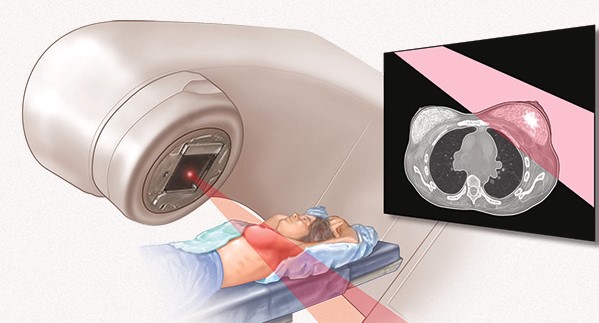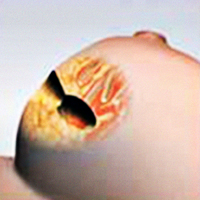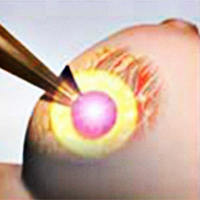Breast Conserving Surgery and Radiotherapy
Radiation therapy after breast conserving surgery is necessary to reduce the risk of cancer local recurrence in the breasts and also reduces the risk of death from the disease.

A meta-analysis by the Early breast cancer Trialist’s collaborative group published in 2011 confirmed that radiation therapy can help prevent breast cancer from recurring by eliminating microscopic disease that remains in the breast after surgery.
It has been reported 90% of the local recurrences occur within the tumour cavity. (Ref : Veronesi U et al, NEJM 2002; 347 : 1227-32)

Radiation therapy for breast cancer after breast conserving surgery can be offered via 2 methods :
- External beam radiotherapy (EBRT)
- Intraoperative Radiotherapy (IORT)
External Beam Radiotherapy (EBRT) for Breast conserving Surgery / Lumpectomy
Breast conserving surgery or lumpectomy with radiation therapy is the current standard of breast cancer treatment for early-stage breast cancer. Radiation therapy significantly reduces at least 60-70% of the relative risk of local recurrences of cancer after breast conserving surgery. Conventionally, radiotherapy is given in a course of 15-25 sessions of external beam radiation to the whole breast (40-50Gy) and sometimes, followed by a boost to the tumor bed (additional 5 sessions) resulting in 3 - 5 weeks of treatment.

Expected Side-effects of External Beam Radiotherapy
- Early changes: General fatigue and weakness, breast skin redness and pain, breast oedema, skin peeling
- Late onset: Breast Fibrosis, Skin hyperpigmentation
- Rare: Pulmonary fibrosis, Cardiac disease
Intraoperative Radiotherapy (IORT)
IORT is a radiation treatment for cancer where radiation is given immediately to the tumor bed upon removal of the tumor at the time of surgery. IORT is only offered to patients in early-stage breast cancer undergoing breast conserving surgery or lumpectomy procedure. The main advantage of IORT treatment is that it can reduce the radiotherapy treatment time compared to conventional external beam radiotherapy after surgery.

How is it performed?

A standard lumpectomy procedure is carried out in the usual manner

When the tumor has been removed, the surgeon positions the Intrabeam applicator directly in the area of the breast where the tumor was located

Low energy radiation is delivered locally and directly to the targeted tissue in the tumor bed for 20-30 minutes. This method minimizes the surrounding healthy tissue from unnecessary radiation exposure

After the 20 – 30mins of radiation therapy, the applicator is removed and the surgeon closes the wound incision
Benefits of IORT
- Shorter treatment time
- IORT can be given as a single therapy during surgery or as a boost with a shorter duration of EBRT rather than a 4-6 weeks course of daily treatment
- Direct delivery of radiation to targeted area
- Protects surrounding healthy tissue
- This reduces toxicity and unnecessary damage to the skin, heart, lungs and the other organs
- Avoids delay
- Radiotherapy does not need to be delayed until after chemotherapy
- Flexible (customized to individual needs)
- IORT can be supplemented with the whole breast EBRT in high risk cases.
- Quality of life and better cosmetic outcome
- The results from the TARGIT trial shows that the cosmetic results of IORT are as good if not better than the traditional EBRT
Side-effects of IORT
Serious complications are rare and side-effects are less than those after EBRT.
- Seroma collection – can be removed through simple aspirations if necessary
- Skin redness and soreness at the incision site
- Generalised fatigue and tiredness
Is IORT effective?
Intraoperative IORT has been extensively researched in clinical trails over 15 years since 1998. There are 300 centres in 35 countries offering TARGIT IORT for breast cancer treatment. The 5-year results of the international TARGIT research group showed that IORT given at the same time as lumpectomy, the local recurrence free survival is similar to conventional external beam radiotherapy.
Who is suitable to receive IORT?
Patients diagnosed with early stage breast cancer from a core needle biopsy and tumor size less than 3cm will be suitable surgical candidate for IORT treatment.
Breast cancer diagnosed via an open surgical lumpectomy will not be advisable to undergo IORT treatment.
IORT can be given in 2 different ways:
- IORT (Single dose): IORT will be given as a single session at the time of the surgery without further need for conventional radiotherapy treatment.
- IORT (Boost): IORT will be given to the tumor bed during surgery and as a boost in *high risk cases. This will be followed by external beam radiotherapy for 15 sessions. Overall duration of treatment will be reduced by 1 week.
*High risk cases that require further external beam radiotherapy after surgery are :
- Lymph node positive for metastasis
- Hormones estrogen and progesterone negative.
- HER 2 positive
- Margins involved.
- Age < 45 years

Note: Your breast surgeon and radiation oncologist will advise if IORT is suitable for you and offer the best treatment option for you.
Links
 Intraoperative Radiation Therapy (IORT): A New Breast Cancer Treatment Innovation by Dr Teoh Mei Shi
Intraoperative Radiation Therapy (IORT): A New Breast Cancer Treatment Innovation by Dr Teoh Mei Shi TARGIT IORT with Intrabeam radiotherapy system for Breast Cancer by Professor Jayant S Vaidya
TARGIT IORT with Intrabeam radiotherapy system for Breast Cancer by Professor Jayant S Vaidya Intraoperative Radiotherapy (IORT) for Breast Cancer by Zeiss
Intraoperative Radiotherapy (IORT) for Breast Cancer by Zeiss Intrabeam Targit IORT by Targit
Intrabeam Targit IORT by Targit
